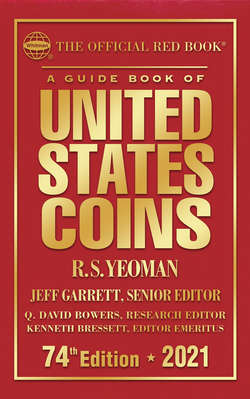Читать книгу A Guide Book of United States Coins 2021 - R.S. Yeoman - Страница 26
На сайте Литреса книга снята с продажи.
The 1962–1964 Treasury Release
ОглавлениеThe Bland-Allison Act of February 28, 1878, a political boondoggle passed to accommodate silver-mining interests in the West, mandated that the Treasury Department buy millions of ounces of silver each year and convert it to silver dollars. At the time, the world price of silver bullion was dropping, and there were economic difficulties in the mining states. From 1878 to 1904 and again in 1921, silver dollars of the Morgan design were minted under this legislation and subsequent acts, to the extent of 656,989,387 pieces. From 1921 to 1928, and 1934–1935, silver dollars of the Peace design were produced in the amount of 190,577,279 pieces.
Although silver dollars were used in commerce in certain areas of the West, paper currency by and large served the needs of trade and exchange. As these hundreds of millions of newly minted dollars were not needed, most were put up in 1,000-coin canvas bags and stored in Treasury vaults. In 1918, under terms of the Pittman Act, 270,232,722 Morgan dollars were melted. At the time, the market for silver was temporarily strong, and there was a call for bullion to ship to India to shore up confidence in Britain’s wartime government. No accounting was kept of the dates and mints involved in the destruction. Just the quantities were recorded (this procedure being typical when the Treasury melted old coins). However, hundreds of millions remained.
Now and again there was a call for silver dollars for circulation, especially in the West; and in the East and Midwest there was a modest demand for pieces for use as holiday and other gifts; in such instances many were paid out. The earlier example of the high-mintage 1901 dollar being rare in Mint State, as most were circulated, is reflective of this. Other coins were stored, such as the aforementioned low-mintage 1884-CC, of which 84.7% were still in the hands of the Treasury as late as 1964! At this time the Treasury decided to hold back bags that were marked as having Carson City dollars, although in records of storage no account was made of them earlier.
Beginning in a significant way in the 1950s, silver dollars became very popular with numismatists. The rarest of all Morgan silver dollars by 1962 was considered to be the 1903-O. In the Guide Book, an Uncirculated coin listed for $1,500, the highest price for any variety. Experts estimated that fewer than a dozen Mint State coins existed in all of numismatics. It was presumed that most had been melted in 1918 under the Pittman Act.
Then this—in November 1962, during the normal payout of silver dollars as gifts for the holiday season, some long-sealed bags of coins were taken from a Philadelphia Mint vault that had remained under seal since 1929. It was soon found that brilliant 1903-O dollars were among these! A treasure hunt ensued, and hundreds of thousands of these former rarities were found. The rush was on!
From then until March 1964, hundreds of millions of Morgan and Peace dollars were emptied from government and bank storage. At one time a long line of people, some with wheelbarrows, formed outside of the Treasury Building in Washington, D.C., to obtain bags of dollars. Finally, only about three million coins remained, mostly the aforementioned Carson City issues, which the Treasury decided to hold back. These were later sold at strong premiums in a series of auctions held by the General Services Administration.
In the meantime, Morgan and Peace dollars became very large and important sections of the coin hobby, as they remain today. However, as can be seen, the combined elements of some coins’ having been melted in 1918, others having been placed into circulation generations ago, and still others existing in Mint State from long-stored hoards, results in silver dollar prices that often bear little relation to mintage figures.
